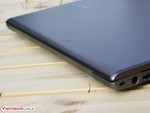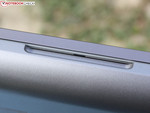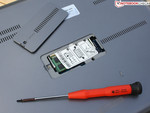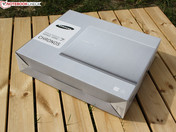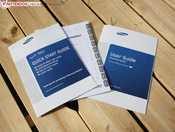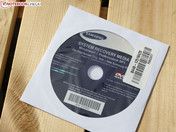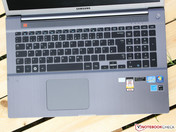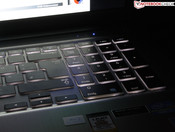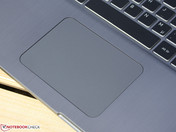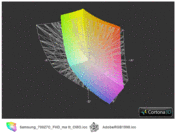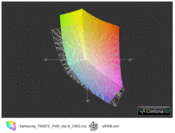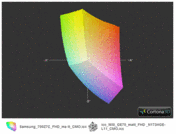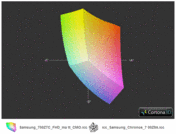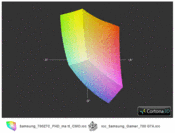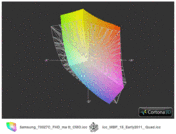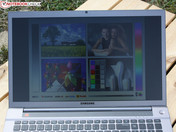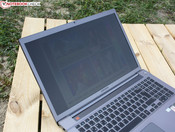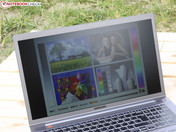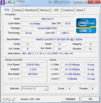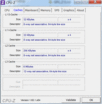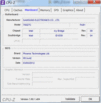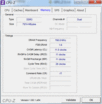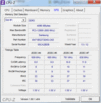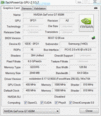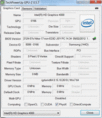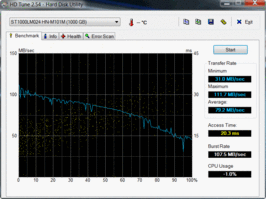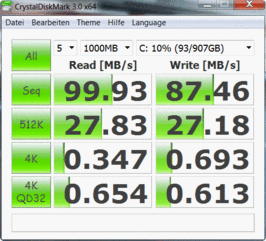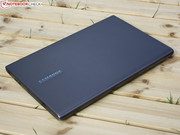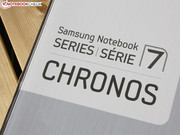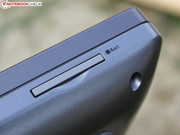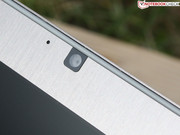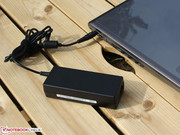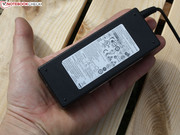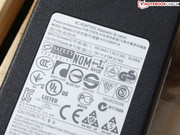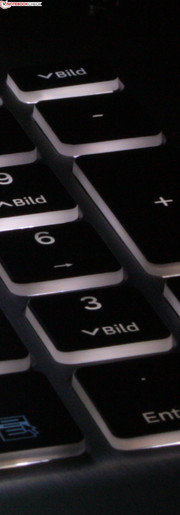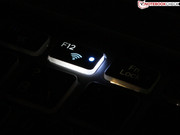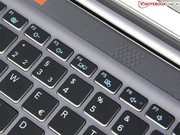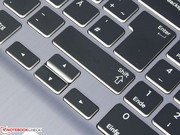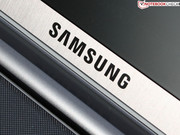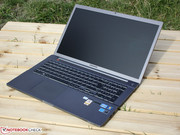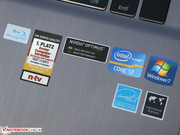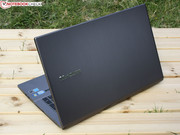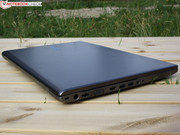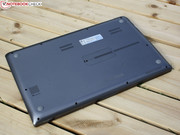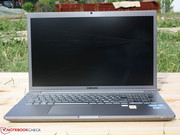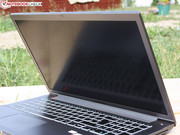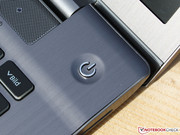Review Samsung Series 7 Chronos 700Z7C Notebook

At Notebookcheck, we are quite familiar with the Samsung Series 7 family of notebooks. We first tested the 15.6 inch 700Z5A and the 17.3 inch 700G7A in 2011 followed by the 14 inch 700Z3A and the 11.6 inch XE700T1A slate in the first quarter of 2012. While the model numbers may seem similar, the hardware and function of each model differ substantially and cover virtually the entire spectrum of notebook computers. The one commonality shared by all four models is their classification as premium devices.
A user choosing the Series 7 family of computing devices ultimately spends a fairly large sum of money, currently starting at 1,462 Euro ($1830 USD), to receive a first-class notebook computer. By comparison, the Series 2, Series 3, and Series 5 families of computers are priced considerably less exclusively. When we reviewed the Samsung Series 7 700Z5A, we found that the unit’s primary and perhaps critical weakness was an inferior display that was considerably behind expectation in the areas of black value, viewing angles, color quality, and contrast. In this review, we will examine the 700Z5A’s larger brother, the Samsung Series 7 Chronos 700Z7C. Will the 17 inch Chronos 17 suffer from the same display weakness as the smaller 15.6 inch Chronos 15 700Z5A or has Samsung improved its display for the larger desktop replacement? Our extensive review attempts to answer this and other questions about Samsung’s latest Series 7 notebook.
Case
The 17 inch Chronos 700Z7C retains both the material and overall appearance of the 15.6 Chronos. The duraluminum finish for the chassis and lid are combined with other aluminum components to create a premium look and feel. All surfaces with the exception of the underside are slightly brushed to give the illusion that the entire case is made from one continuous sheet of aluminum. This illusion is strengthened by the case’s minimal clearance, a trait that owes to Samsung’s very precise and exact assembly of the unit. The notebook has a fairly high weight which also furthers the case’s impression of stability.
The notebook’s main surface has a non-skid feel to it and offers a large amount of space, allowing even the largest hands to fit on the keyboard rest. As opposed to some other notebooks, fingerprints are mostly invisible. The completely-flat wrist rest stays cools during operation. While the Chronos’s base unit is not completely stiff, we were unable to cause the keyboard to bend or dent anywhere. The notebook’s chassis is quite stable compared to other notebooks and can only be minimally bent even when using both hands. The optical drive can be pressed in slightly from underneath.
While the base unit gave us a good impression of the unit, the display lid provides quite the opposite. The hinge does keep the TFT display in position and deflects only slightly during movement but the screen can be pushed to the left and right. As this deflection is only minimal, this should not be major problem but it does exist. The display has a hard back lid which prevents denting from behind the screen. The distance between the display and the base unit is maintained by small rubber lips positioned at the top and bottom of the display.
On the underside, a small maintenance hatch offers access to the system’s single memory bank. Our unit came preinstalled with 4 GB of system memory in this slot. An additional 4 GB of system memory is embedded directly into the notebook’s motherboard. Changing the hard drive would require the entire case bottom to be unscrewed and removed. The battery is built-in and cannot be replaced.
Connectivity
Virtually all of the Chronos’s connectors have been placed on the left side of the base unit with the 4-in-1 card reader being located on the front and two USB 2.0 ports being located on the right side. No connectors are found on the rear edge. The 700Z7C features a DisplayPort connector, allowing the notebook to connect to external displays. Besides a few models from HP and Dell, few notebooks offer this interface.
We found the positioning of the connectors to be good as it allows for the routing of cables to the rear-left of the unit. This leaves the right side of whatever surface on which the notebook rests to stay clear of tangled cables. A true docking station, as opposed to a USB port replicator, is not available for the Chronos series.
Communication
The 17 inch Chronos includes the Intel Centrino Advanced-N 6235 card which supports 802.11 Draft N and Bluetooth 4.0. The Realtek PCIe GBE Family controller allows for Gigabit wired networking.
Software
Samsung includes a system recovery disk, a rare but welcome inclusion. A copy of Windows 7 Professional Edition (64-bit) is also included. The notebook comes with EasyMigration for data migration, Easy File Share for accessing data from another PC, and the Software Launcher Widget for Windows 7.
Warranty
Samsung provides a 24 month warranty. This warranty can be extended to 3 years for 50 Euro ($60 USD) or 4 years for 99 Euro ($125 USD). Both warranty extensions include pick-up service. All warranties begin on the date of purchase and extensions must be purchased within 90 days of original purchase.
Input devices
Keyboard
The Chronos 700Z7C features a matte, visually appealing keyboard that is recessed into the base unit. Pressed keys are further recessed into the aluminum base unit by about 1 millimeter (0.04 inches). The smaller F-Keys have no curvature and are completely flat. Dedicated and fast typing is no problem due to the clear pressure point, the light rubber coating, and a 3 millimeter gap between keys. The keys have a medium key drop and the key stroke is firm but not hard.
The 17 inch Chrono’s larger dimensions allow the wrist rest to offer plenty of space for even large hands. This additional space also allows the built-in keyboard to feature a full-sized, four column numpad and full-sized Enter, Shift, and Backspace keys. The smaller, offset arrow keys are distinct and can be found by touch. The keyboard’s backlight can be adjusted to one of 8 different intensities or turned off completely and proves convenient for dark working environments. The illumination can also be activated automatically by the brightness sensor located next to the HDD status LED if properly configured.
Touchpad
The Chronos features a 12.6 centimeter (4.96 inch) wide matte touchpad that supports multi-finger gestures and has good gliding capabilities. The matte finish prevents the unsightly accumulation of fingerprints. As with many notebooks, the touchpad uses seamless left and right mouse buttons located beneath the touchpad surface toward the bottom. The key drop is distinct with a travel distance of approximately 2 millimeters (0.1 inches). The key stroke is clear but soft and the resulting click is quiet.
The special feature of this touchpad is its left mouse button which extends throughout the entire touch surface, allowing a user to press anywhere to register a left mouse click. Sadly, we found this to be too stiff and only functions properly in the middle of the pad. Moving from the center of the pad, the key stroke drops off quickly and disappears completely at the edges.
The Chronos uses a 1920x1080 Full HD, matte anti-glare Chi Mei (CMO) display. The combination of high resolution, albeit standard for this class, and anti-glare matte coating makes this display ideal for all scenarios. We measured a black level of 0.3 cd/m2 at the center of the display under maximum illumination. This resulted in a high contrast ratio of 870:1 and we found the colors to be crisp and intense.
| |||||||||||||||||||||||||
Brightness Distribution: 86 %
Center on Battery: 261 cd/m²
Contrast: 870:1 (Black: 0.3 cd/m²)
69.7% AdobeRGB 1998 (Argyll 3D)
92.5% sRGB (Argyll 3D)
75.1% Display P3 (Argyll 3D)
We used the i1Display color calibration tool to compare the display’s color space with the AdobeRGB and sRGB color palettes. We found the color space to be weak and graphics professionals may find the display inadequate for their needs as neither palette could be accurately reproduced. The panel displayed too much saturation in the green-red area of the spectrum. Nonetheless, the results are still much better than those of the 15.6 inch Chronos 700Z5A, and the 17.3 inch Samsung Gamer 700G7A and MSI GE70.
The built-in ambient light sensor located next to the HDD status LED allows the TFT display to automatically adjust its own illumination level. After disabling this sensor in the included Chronos Control Center, we observed a maximum illumination of 261 cd/m2 in the middle of the display in our bright sunlight test. We found the illumination to be consistent and steady with a distribution of 86 percent.
In our tests, we found the viewing angles to be of mixed results. The picture remained stable without color inversion through a horizontal arc of close to 180o, allowing the user to view the display contents from nearly any aspect. On the vertical axis, however, viewing stability was much lower with the contents displaying color inversion at angles of 35o and greater. It should be noted that visual stability is rare even in expensive models and therefore this panel meets the requirements of the premium Chronos series.
Both the maximum brightness and the anti-glare matte coating of the display were evident in our bright sunlight test. Our results are displayed in the three photos above. We found the visual results sufficient to provide a clear image from both front and side angles. The aforementioned vertical viewing angle prevents the display from being truly exceptional in outdoor use.
Performance
The Chronos 700Z7C is one of only a handful of notebooks to offer the 2.3 GHz Intel Core i7-3615QM over its quad-core sister Intel Core i7-3610QM. The 3615QM is an Ivy Bridge processor that has a maximum Turbo Boost 2.0 speed of 3.3 GHz provided the internal cooling system can handle such speeds.
As with all Ivy Bridge processors, the DDR3 controller and Intel HD Graphics 4000 are integrated into the processor package. As well as the integrated GPU, the Chronos 17 inch includes a dedicated GeForce GT 650M with 1 GB GDDR5 memory. As with other Nvidia cards, Optimus enables the system to automatically switch between the integrated GPU and the dedicated GPU depending on which is required for performance and efficiency. The system also features 8 GB DDR3 with 4 GB of that being embedded into the motherboard and the other 4 GB found in a single memory bank.
Processor
The 17 inch Chronos offers only one option at processor. Nonetheless, the Core i7-3615QM is sufficient for virtually all tasks and can serve equally well in the roles of productivity, multimedia, and desktop replacement. In single-core and multi-core testing, we found that the i7-3615QM ranked very closely to its sister model, the Core i7-3610QM which is used in many economical gaming notebooks such as the Asus A95VM-YZ030V and features the same clock speed.
In the multi-core Cinebench R11.5 64-bit test, the CPU scored 6.26 points, over twice the points of the dual-core i5-2430M – which scored 2.67 points – found in the 15 inch Chronos 700Z5A-S01DE. This result is expected as the i7-3615QM simultaneously handles 8 threads compared to the i5-2430M’s four threads. The i7-3615QM even stands up against the more expensive Core i7-3920XM found in the Schenker XMG P702 Pro and the higher-clocked Core i7-3720QM found in the Asus G75V. These processors scored 7.07 and 6.80 points respectively, representing modest improvements of 13% and 9%.
We used the Cinebench R10 64-bit single CPU test to compare single-core operations. In this test, the i7-3615QM’s Turbo Boost 2.0 should allow the single core to overclock itself to a speed of 3.3 GHz if the designed cooling system is sufficient. We observed a maximum speed of 3.2 GHz for the i7-3615QM which scored 5,618 points. This score is only slightly better than the 4,800 points scored by the i5-2430M. This shows that the quad-core i7-3615QM outperforms every currently available dual-core processor regardless of the process and that this performance gap increases when the i7-3615QM can fully utilize its four cores and eight threads.
System Performance
In the PCMark 7 system performance test, our Chronos 17 scored 3,281 points with the HDD scoring particularly well with 2,638 points. By comparison, the Chronos 15 with its Sandy Bridge i5-2430M processor, 7200 RPM HDD, and Radeon HD 6750M scored 2,350 points and a comparably high 2,230 points for its HDD. Had either notebook used an SSD as its storage solution, a score of at least 3,750 points would have been possible and the storage score would have been in the 4,000 to 5,000 point range as was the case with the Schenker XMG A502 featuring an Nvidia GeForce GT 650M.
| PCMark Vantage Result | 8658 points | |
| PCMark 7 Score | 3281 points | |
Help | ||
Storage Devices
While the Chronos 700Z7C does include a SanDisk P4 8 GB iSSD, it merely serves as the ExpressCache buffer for the 1 TB Seagate Momentus SpinPoint M8. The SSD ensures that the system can resume from standby quickly and makes for short boot and loading times.
We consider the combination a clever move by Samsung. The user has both the large storage space of a traditional physical disk and still benefits from the faster loading and boot times of an SSD. However, application performance, such as copying data that is fragmented over the disc, cannot be accelerated by the iSSD. Only data blocks that are loaded recursively can be placed on the SSD and this applies mainly to data from the operating system and from active applications such as Microsoft Office Suite and games.
The 5400 RPM Momentus features a relatively slow rotational speed but nonetheless manages to surprise us with its high read/write speed. We achieved transfer rates of 79 MB/s in HD Tune and 100 MB/s in CrystalDiskMark for large, non-fragmented data. When this level of performance is combined with the large capacity, the Momentus certainly looks appealing. That said, the drive demonstrated a significant weakness in its very bad access time of 20.3 milliseconds. Other comparable hard drives, such as the 7200 RPM Hitachi Travelstar 7K750 HTS727575A9E found in the Samsung 550P7C-S02DE, have access times of approximately 16 milliseconds. As a consequence of this slow access time, the transfer of small or fragmented data was very slow as shown in our CrystalDiskMark 4k tests.
Graphics Card
We used the Unigine Heaven 2.1 benchmark to test the DirectX 11 performance of the Chronos 17’s GeForce GT 650M. The 650M achieved 36 frames per second (fps), a result close to those of the older GeForce GTX 570M, which managed 35 fps, and the Radeon HD 6990M which attained 37 fps. The newer GeForce GTX 670M proved to be the next step up with a 39 fps performance.
In 3Dmark11, the GeForce GT 650M scored 2,324 points and was slightly faster than the GeForce GTX 560M and the Radeon HD 7670M. This places the buyer of a Chronos 700Z7C in the upper class of mobile GPUs even if the GeForce GT 650M is one of the slower models of this class.
| 3DMark 06 Standard Score | 14172 points | |
| 3DMark Vantage P Result | 10046 points | |
| 3DMark 11 Performance | 2324 points | |
Help | ||
Gaming Performance
For many users, the appeal of a notebook with a GT 650M GPU is the ability to play games on the go. To demonstrate the Chronos 700Z7C’s capabilities, we tested four games.
Overall, we observed results in our gaming benchmarks that were consistent with other GT 650M-based systems with minor deviations for better or worse. We did not observe any impact from CPU throttling on game performance. In some scenarios, the GT 650M surpassed the former high-end GeForce GTX 560M.
In our first tested game, Rage, we were capable of playing the game at 59 fps using ultra settings and Full HD 1920x1080 resolution.
In our second test game, Batman: Arkham City, we immediately chose the highest settings and found the resulting 25 fps disappointing. The XMG A502, which also features the GT 650M, had a comparable result at 24 fps. It would appear that one must have either a GTX 580M or a GTX 660M, which managed 31 fps in the Asus G55VW-S1020V, to play this game at highest settings.
Our third test game, Modern Warfare 3, was not particularly demanding and proved to be fairly easy for our GeForce GT 650M which ran the game at 45 fps. This was the best result within notebooks of this class. By comparison, the MSI GE70-i547W7H achieved only 40 fps.
Our last test game, Max Payne 3, stuttered using high settings and only reached a maximum of 23 fps. In our experience, this is typical for GT 650M-based devices. The comparably equipped MSI MS-16GA managed 22 FPS. To achieve better frame rates, a GTX 580M or a Radeon HD 6990M is required. These GPUs managed 30 and 38 fps respectively.
In conclusion, the Geforce GT 650M is capable of playing all games in our test battery, albeit with some caveats regarding detail levels and resolutions. As a multimedia GPU, the GeForce GT 650M is an excellent choice. If the user is willing to occasionally reduce display resolution, for example to 1366x768, most current titles will be playable without issue.
| low | med. | high | ultra | |
|---|---|---|---|---|
| Batman: Arkham City (2011) | 56 | 25 | ||
| CoD: Modern Warfare 3 (2011) | 45 | |||
| Max Payne 3 (2012) | 23.1 | 18.9 |
Emissions
System Noise
While idle, the Chronos 17 remained noticeably audible at all times. Subjectively, the majority of this came from the HDD with the rest coming from the fan. The internal fan only switched off when using Samsung Silent Mode which is activated via the Fn-key with a fan symbol on it. The quiet 30.4 dB(A) of the HDD virtually required us to place an ear to the notebook to hear the HDD’s operation at idle. Occasional tasks and surfing the Internet increased the noise slightly to a still-quiet 32.6 dB(A).
We placed the processor and GPU under load using 3DMark Vantage and Cinebench R11.5. The 17 inch notebook became more audible and reached the 40 dB(A) mark quickly. It is reasonable to assume that this noise level represents normal use such as playing games and while running CPU-intensive applications. In our stress test, we observed a constant noise level of 40.8 dB(A).
Noise level
| Idle |
| 31.7 / 31.8 / 32.6 dB(A) |
| HDD |
| 31.7 dB(A) |
| DVD |
| 40.8 / dB(A) |
| Load |
| 33.1 / 39.7 dB(A) |
 | ||
30 dB silent 40 dB(A) audible 50 dB(A) loud |
||
min: | ||
Temperature
Most users will likely enable Silent Mode for idle and office use. In this mode, the fan was completely deactivated and heat built up in the chassis, raising the temperature to 40oC (104oF). As a safeguard, the processor clock was limited to 1.2 GHz but the GPU remained at 835 MHz core clock and 1 GHz memory clock. This situation does not occur when silent mode is disabled as the fan continuously operates to expel heat.
After a few hours of load, the temperature of the notebook rose considerably. We measured a maximum temperature of 53oC (127oF) in the middle of the keyboard and above the fan and an average temperature of 39oC (102oF). The cooling system has two vents, located below the display hinges. The area around the vents became quite hot during operation.
Throttling Under Load
Using Prime95 and Furmark to saturate load on both the CPU and GPU, we conducted a stress test on our Chronos 17. During this test, we found that the system ran at a constant clock speed of 2.3 GHz and consumed 95 Watts on AC power. After 10 minutes, the power supply heated up significantly to 61oC (142oF) and the power consumption fluctuated continuously between 93 and 95 Watts. At this point, the CPU clock speed dropped to 2.1 GHz. Continuing our stress test, we observed a continuous consumption of 94 Watts and a CPU clock speed between 1.4 GHz and 1.8 GHz. The CPU reached a temperature of 94oC (201oF) at this point and the battery started being drained as a result of the power supply providing insufficient power.
From these observations, it would appear that our stress test pushed the CPU to its thermal limit and the power supply to its power limit. It became obvious that the power supply has virtually no design overhead and cannot supply more than the specified 90 Watts. These factors caused the CPU to throttle down but did not affect the GPU as its core clock maintained operation at 835 MHz, the maximum Nvidia Boosted core clock. The GPU temperature held steady at a normal temperature of 84oC (183oF). These physical measurements reflect our benchmark results that showed the CPU underwent throttling during GPU load. For example, in the Cinebench R11.5 64-bit multiple CPU test, we achieved a score of 4.07 during our stress test compared to the 6.26 points during our previous test. We also observed that single CPU benchmarks did not demonstrate any throttling and maintained their non-stressed scores.
The important question here is whether or not this throttling appears in real world situations. Our stress tests simulated extreme situations, placing 100% load on both the CPU and GPU. Such a situation is very uncommon and usually does not appear even while playing demanding games. On the other hand, the rapid heating of the CPU led to a significant performance decline. We ran 3DMark06 immediately after our stress test and achieved a score of only 13,702. This is merely a measurement, however, and users will not notice this performance decrease in normal use.
As a final note, it should be mentioned that the Chronos 17 has a BIOS option called “Turbo Control“. This option deactivates CPU Turbo Boost overclocking when a certain manufacturer preset temperature is reached. This preset temperature cannot be adjusted and Turbo Control is enabled by default. We disabled this option, ran our benchmarks again, and observed no noticeable changes regarding the CPU clock and power consumption.
(-) The maximum temperature on the upper side is 53.2 °C / 128 F, compared to the average of 36.9 °C / 98 F, ranging from 21.1 to 71 °C for the class Multimedia.
(-) The bottom heats up to a maximum of 53.7 °C / 129 F, compared to the average of 39.2 °C / 103 F
(±) In idle usage, the average temperature for the upper side is 34.4 °C / 94 F, compared to the device average of 31.3 °C / 88 F.
(+) The palmrests and touchpad are reaching skin temperature as a maximum (34.5 °C / 94.1 F) and are therefore not hot.
(-) The average temperature of the palmrest area of similar devices was 28.7 °C / 83.7 F (-5.8 °C / -10.4 F).
Speakers
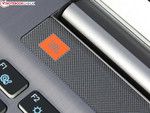
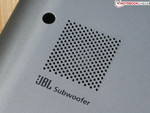
Whereas the Chronos 15 left us with a bad impression of its audio capabilities, we found the sound quality of the Chronos 17 to be completely different and superb. The Chronos 17 is equipped with not only a pair of JBL speakers located in the ledge above the keyboard but also a subwoofer, something that was sorely lacking in Chronos 700Z5A. The 2.1 speaker combination results in clear and excellent voice reproduction and clearly noticeable bass which can be felt through the wrist rest. Classical music, which typically shows a speaker’s limitations with its sharp treble and deep bass tones, can be played back well and without fault on the Chronos 17. Subjectively, we found the acoustics to mimic those of the 17 inch Series 5 550P7C.
The speakers are augmented by the included SoundAlive software which serves as equalizer and has audio effect presets for different genres of music as well as movies. These presets allow the user to achieve the desired listening experience immediately.
In our testing, we found the speakers were capable of high volumes producing only a light roar, if at all. The high quality of the speakers eliminates the need for external speakers. However, the combination headset / microphone jack is a bit below expectation for a premium 17 inch desktop replacement. Those seeking to use both external speakers or headset and a microphone at the same time will need to use either USB or HDMI for audio output.
Power Consumption
While idle, the Chronos 17 consumes between 12 and 21 Watts. The low end of the consumption range reflects an energy-saving, minimum brightness profile with wireless disabled. The high end of the range reflects a maximum power profile with the display at maximum brightness and wireless enabled. This idle power consumption is typical for a quad-core notebook of this size class. We recently tested the quad-core 18.4 inch Asus A95VM which consumed between 14 and 24 Watts under the same conditions. By comparison, the Series 5 550P7C consumed between 9 and 15 Watts despite being in the same class and featuring the same equipment.
In our stress test, the Chronos 17 constantly consumed 95 Watts. The consumption did not vary despite the fact that the 90 Watt power supply was overtaxed and heated up to 61oC (142oF). The underpowered power supply forced the system to draw power from the battery to cover the shortage. When loading only the CPU using Prime95, the system consumed 60 Watts and the CPU was not throttled. When loading only the GPU using Furmark, the system drew 69 Watts.
| Off / Standby | |
| Idle | |
| Load |
|
Key:
min: | |
Battery Runtime
The included Lithium-Ion battery has a rated capacity of 81.4 Wh (5,653 mAh) and delivers very good runtimes relative to the system’s form factor. We reached this conclusion after conducting runtime assessments using four scenarios.
In the first of these scenarios, we simulated a minimal consumption scenario using Battery Eater’s Reader Test with brightness at minimum and wireless disabled. In this scenario, we achieved a runtime of 9:58 hours. In the second scenario, we simulated a modest usage scenario by surfing the Internet with Wi-Fi enabled and brightness set to approximately 150 cd/m2. This yielded a runtime of 4:11 hours.
In our third scenario, we simulated watching a movie from the DVD optical drive and our battery lasted approximately five hours followed by a 2:44 recharge cycle. In our last scenario, we set brightness to maximum and turned on the wireless module. Placing the system under load conditions, the battery runtime was reduced to two hours.
It should be noted that the BIOS allows the user to reduce the effective battery capacity to 80% of maximum to increase the life cycle of the battery itself. This option is designated “Battery Life Cycle Extension”.
Verdict
In the Chronos 17, Samsung took the two most significant weaknesses of the Chronos 15 – the weak display and sub-premium speakers – and upgraded them to a high brightness CMO TFT display and a JBL 2.1 speaker system. Components like these are the reasons why buyers pay extra for premium notebooks. The 17.3 inch notebook balances its roles as a mobile workhorse and as a multimedia desktop replacement due to the combination of components – quad-core Ivy Bridge CPU, Full HD matte TFT display, illuminated keyboard, GeForce GT 650M GPU, and Blu-ray reader.
The heart of the system is the new quad-core 2.3 GHz Core i7-3615QM. Combined with the Geforce GT 650M, users are ensured of a capable system for the next few years that is capable of running modern games. Users interested in both silent operations and the highest tier of performance will undoubtedly miss a Solid State Drive which would have certainly given the entire system an enormous performance boost. The expected runtimes of four to five hours are good and can be a significant advantage, especially when working outdoors. Outdoor feasibility is accomplished through a bright anti-glare screen that features good viewing angles.
Customers whose primary criterion is a high-quality Full HD display and appreciate precise manufacturing should give the Chronos 17 series a closer look while simultaneously steering clear of the Chronos 15 series from 2011.




